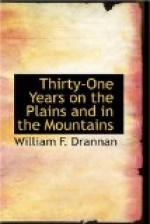The next morning we loaded up our furs and pulled out, telling the chief that we would be back in one moon—meaning in their language, one month—which would keep us busy, it being about four hundred miles to Bent’s Fort, and as we were heavily loaded we would have to travel slow. The Mexican boy would ride ahead and the pack horses would follow him, while Jim and I brought up the rear. We experienced no trouble in getting all the buffalo meat we wanted, for those beasts were quite tame at this season of the year, and they would often come near our camp. So near, in fact, that we could sit in camp and kill our meat.
Upon our arrival at the fort Col. Bent and Mr. Roubidoux were well pleased with the success of the trip, and we at once started back after the second load. We found more furs and robes there awaiting our arrival than we could load on our horses. In all we made four trips that winter, and Col. Bent told me some time afterward that they cleared a thousand dollars on each cargo.
When spring came Jim Bridger and I went to Taos and visited Uncle Kit for about a month.
This was now the spring of 1859 and the excitement over the gold mines around Pike’s Peak was running high. We all knew where Pike’s Peak was, for any day when it was clear we could see it very plainly from Bent’s Fort or Taos, but we did not know just where the mines were. Jim proposed that we take a trip out there and see about the mines. So we talked the matter over until I was finally attacked with that disease which was then known as “the gold fever.”
About the first of June we made a break for the gold fields. We crossed the Arkansas river near Fountain ca-booyah (or something like that)—(Fountain qui Bouille, Boiling Fountain)—and did not go far from there until we struck a wagon road, which showed there had been much travel, and we could see that it had not been long since a wagon passed.
We were very much surprised at a wagon road in this portion of country, but there it was just the same. We did not travel on this road very far until we overtook a large train of emigrants, and on making inquiry we learned that they were on their way to Pike’s Peak.
Jim Bridger laughingly remarked: “If you are not careful you will pass Pike’s Peak before you go there, for there is the mountain,” pointing to the Peak, the foot of which we were just then passing. At this another man said: “We are going to Cherry creek to the mines. Do you know how far it is?”
I told him it was twenty miles to the head of Cherry creek. He then asked me how far it was to Denver. I told him I had never heard of any creek or river by that name in this country. “But,” he said, “I mean Denver City.” But Jim and I had never heard of the place. He said Denver City was on Cherry creek in the gold mines.
We passed on, crossing the main divide between the Arkansas and the Platte rivers, striking the head of Cherry creek, then traveled down Cherry creek to the mouth, on a now well-beaten wagon road, the dust in places being six inches deep or more.




